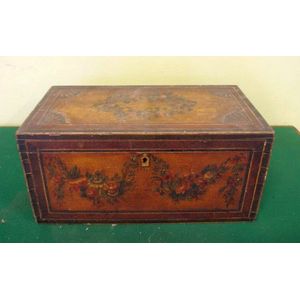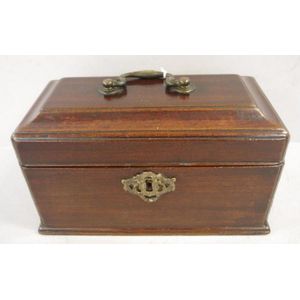Anglo-Indian Timber and Brass Jewellery Box
You must be a subscriber, and be logged in to view price and dealer details.
Subscribe Now to view actual auction price for this item
When you subscribe, you have the option of setting the currency in which to display prices to $Au, $US, $NZ or Stg.
- Arabesque - The arabesque pattern is an ornamental design that features flowing, curving lines and elaborate geometric shapes. It is inspired by the art and architecture of the Islamic world and was developed at Fontainebleu France in the mid 16th century. Its use was spread through published engravings, and it is characterized by its intricate and highly decorative nature. The arabesque pattern is created using a repetitive motif that is repeated and interwoven to create a cohesive design. It was used as a form of decoration in art, architecture, textiles, pottery, furniture and ceramics and it is often used to add a sense of grandeur and sophistication to a design. The arabesque pattern is admired for its beauty and complexity, and it continues to be used in a wide range of decorative contexts today.
This item has been included into following indexes:
Visually similar items

Antique handpainted work box, 33 cm x 17 cm, 16 cm high approx.

Regency IV tea caddy, made from Brazilian rosewood, with 3 section interior and lidded compartments, ivory shield escutcheon. 18 cm by 33 cm long.

A Regency period, rosewood and brass inlay sarcophagus shape, tea caddy, c.1820-1830, with two pullout canister boxes and central cut crystal mixing bowl. Height 19.2 cm. Length 30 cm. Depth 16 cm

George III Cuban mahogany tea caddy, with quarter columns, triple oak interior divisions and original brass lid handles, c1770.
